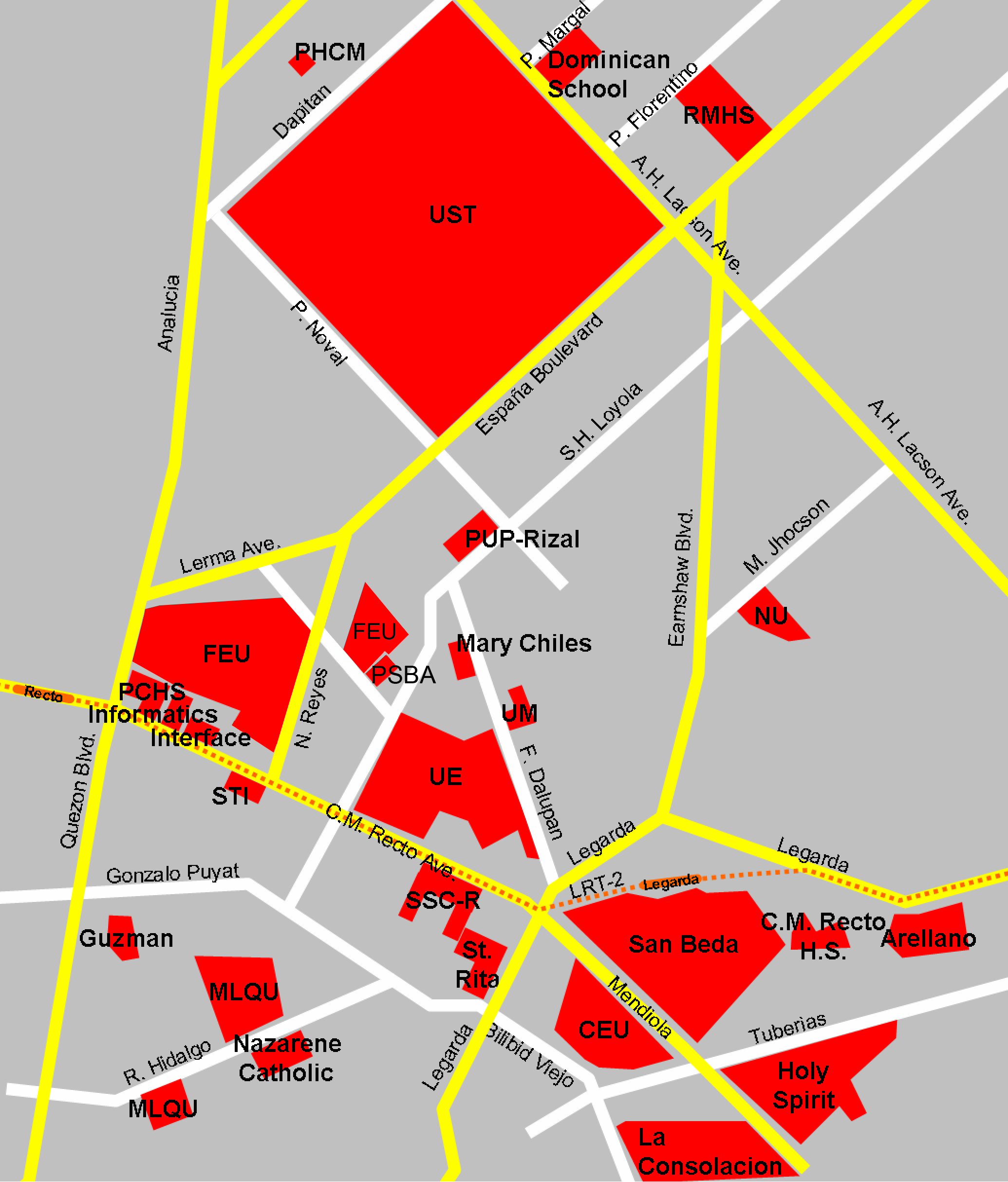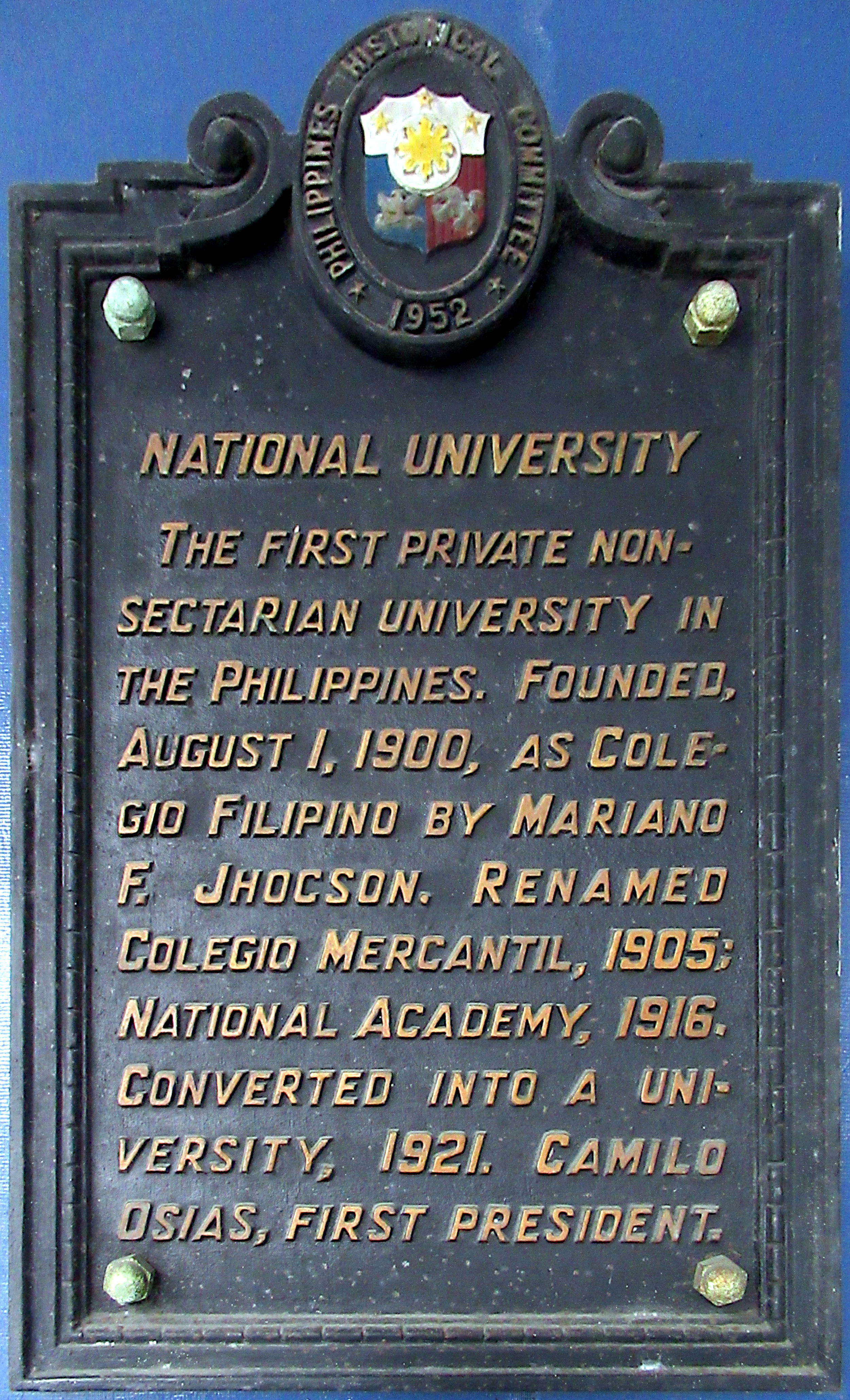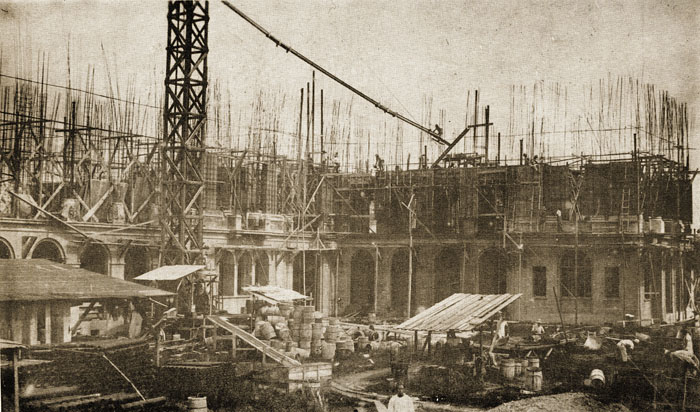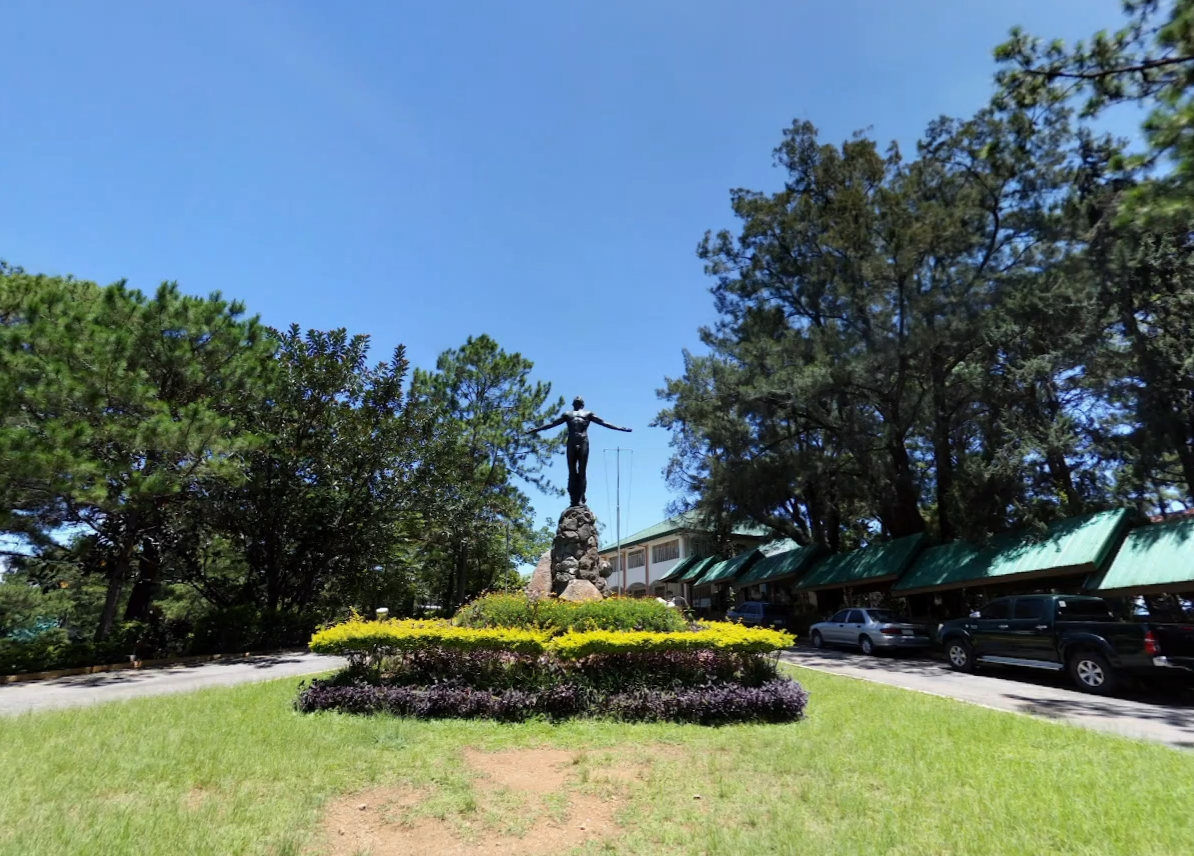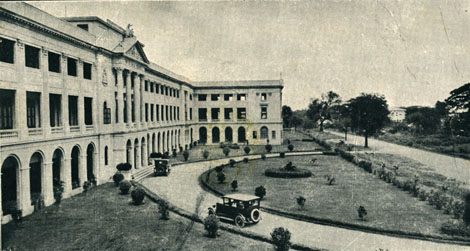|
University Belt
The University Belt is a '' de facto'' subdistrict in Manila, Philippines, referring to an area with a significant concentration of major colleges and universities in the city. The districts of Quiapo, Sampaloc, and San Miguel are traditionally considered areas of the University Belt. Other clusters of schools along the southern bank of the Pasig River, mostly in the districts of Intramuros and Ermita and the southernmost part of Malate near the city limits, are also sometimes included. Each of the colleges and universities in the district is within walking distance of each other. History Since the Spanish colonial period, Manila has been the center of education in the country, and Intramuros was home to various academic institutions. The first schools in the district were the Colegio de Santa Potenciana founded in 1589,Perez Dasmarinas, Luis. Letters from Luis Perez Dasmariñas to Felipe II. In The Philippine Islands, 1493-1898. Ohio: A.H. Clark Company, 1903-9. Vol. 9 ... [...More Info...] [...Related Items...] OR: [Wikipedia] [Google] [Baidu] |
National University (Philippines)
National University () commonly known as NU, colloquially ''National U'', is a private non–sectarian university located in Sampaloc, Manila, Philippines. The founder of the university, Mariano F. Jhocson Sr., established the institution on August 1, 1900, as ''Colegio Filipino'' in Quiapo, Manila, Quiapo, Manila. It is considered as the first Private university, private nonsectarian and coeducational institution in the Philippines and also, the first university to use English as its medium of instruction, replacing Spanish. With its main campus in Sampaloc, Manila, the university has been expanding by setting secondary campuses. Other campuses of NU includes: NU Nazareth School, NU Laguna (Sports Academy), NU Fairview, NU Mall of Asia, NU Baliwag, NU Dasmariñas, NU Lipa, NU Clark, and NU Bacolod, among others. Additionally, the institution leased a part of the lot and buildings of the former College of the Holy Spirit Manila in Mendiola, Manila and will be known as the upcom ... [...More Info...] [...Related Items...] OR: [Wikipedia] [Google] [Baidu] |
Santa Cruz, Manila
Santa Cruz is a district in the northern part of the Manila, City of Manila, Philippines, located on the right bank of the Pasig River near its mouth. It is bordered by the districts of Tondo, Manila, Tondo, Binondo, Manila, Binondo, Quiapo, Manila, Quiapo, and Sampaloc, Manila, Sampaloc, as well as the areas of Grace Park and Barrio San José in Caloocan, and the district of La Loma in Quezon City. The district belongs to the Manila's 3rd congressional district, 3rd congressional district of Manila. History Spanish colonial era Prior to the arrival of the Spain, Spanish conquistadors to the Philippine archipelago in 1521, the district of Santa Cruz was partly Marsh, marshland, patches of greenery, orchards, and Paddy field, ricefields. A Spanish expedition in 1581 claimed the territory and awarded it to the Society of Jesus. The Jesuits then built the first Catholic church in the area, where the present Santa Cruz Church (Manila), Santa Cruz Church stands on June 20, 1619. T ... [...More Info...] [...Related Items...] OR: [Wikipedia] [Google] [Baidu] |
Coconuts Media
Coconuts Tabloid Media was a multi-national media company across Hong Kong that published a network of local city websites and documentary videos online. The company served ten cities and countries across South East Asia, namely Bangkok, Manila, Hong Kong, Singapore, Kuala Lumpur, Jakarta, Bali and Yangon, covering local news and cultural trends. Coconuts Media used social media and video platforms to increase its reach. In addition to English, the company produces content in Thai and Indonesian. Coconuts Media employed around 40 staff members as of August 2016, half of whom are in editorial. In 2015, it had a reported total monthly reach of 14.6 million unique readers across all platforms. History Beginnings and growth (2011) Coconuts Media was inspired by US-based blogs such as the Gothamist network and New York's Gawker, as well as BuzzFeed and Vice. The company was founded by American journalist and entrepreneur Byron Perry, out of his Bangkok apartment in September 19, ... [...More Info...] [...Related Items...] OR: [Wikipedia] [Google] [Baidu] |
De La Salle University
De La Salle University (), also referred to as DLSU, De La Salle or La Salle, is a private, Catholic coeducational research university run by the Institute of the Brothers of the Christian Schools with main campus in Taft Avenue, Malate, Manila, Philippines. It was established by the Christian Brothers in 1911 as De La Salle College (DLSC) in Nozaleda Street, Paco, Manila with Blimond Pierre Eilenbecker, FSC serving as director, and is the first De La Salle school in the Philippines. The college was granted university status on February 19, 1975, and is the oldest constituent of De La Salle Philippines (DLSP), a network of 16 educational institutions, established in 2006 replacing the De La Salle University System. The institution started as an exclusive all-boys elementary and high school. In 1920, it began offering a two-year Associate in Arts Commerce program, which was later discontinued in 1931 in favor of a Bachelor of Science in Commerce program. De La Salle Univers ... [...More Info...] [...Related Items...] OR: [Wikipedia] [Google] [Baidu] |
University Of The Philippines
The University of the Philippines (UP; ) is a Higher education in the Philippines#State universities and colleges, state university system in the Philippines. It is the country's national university, as mandated by List of Philippine laws, Republic Act No. 9500 (UP Charter of 2008), giving it institutional autonomy. Originally founded by the Insular Government, American occupational government on June 18, 1908, it was established through the ratification of Act No. 1870 of the 1st Philippine Legislature to serve as an "advanced instruction in literature, philosophy, the sciences and arts, and to give professional and technical training" to eligible students regardless of "age, sex, nationality, religious belief and political affiliation." The University of the Philippines system has 8 constituent universities (CUs) and 1 autonomous college: University of the Philippines Diliman, UP Diliman, which serves as the system's flagship university, University of the Philippines Los B ... [...More Info...] [...Related Items...] OR: [Wikipedia] [Google] [Baidu] |
University Of The Philippines Manila
The University of the Philippines Manila (UPM; ) is a Higher education in the Philippines#State universities and colleges, public research university located in Ermita, Manila, Ermita, Manila, Philippines. It is the oldest of eight constituent universities of the University of the Philippines, University of the Philippines System, and predates the founding of UP by three years. It was originally established on December 1, 1905, as the Philippine Medical School and later renamed as the University of the Philippines College of Medicine, UP College of Medicine and Surgery on June 10, 1907. In 1983 it was renamed as University of the Philippines Manila. UP Manila administers and operates the Philippine General Hospital, the largest medical center and the national referral center for health in the Philippines. The university is the home of the National Institutes of Health (Philippines), National Institutes of Health. This section led early testing for COVID-19. It continues to cond ... [...More Info...] [...Related Items...] OR: [Wikipedia] [Google] [Baidu] |
Taft Avenue
Taft Avenue (; ) is a major road in southern Metro Manila. It passes through three cities in the metropolis: Manila, Pasay, and Parañaque. The road was named after the former Governor-General of the Philippines and President of the United States, U.S. President William Howard Taft; the Philippines was a former Commonwealth (U.S. insular area), commonwealth territory of the United States in the first half of the 20th century. The avenue is a component of National Route 170 (N170), a secondary road in the Philippine highway network and Radial Road 2 (R-2) of the List of roads in Metro Manila, Manila arterial road network. Route description From the north, Taft Avenue starts as an eight-lane avenue, with four lanes per direction, at the Lagusnilad vehicular underpass at its intersection with Padre Burgos Avenue in Ermita, Manila, Ermita. It then crosses Ayala Boulevard and Finance Street and forms the eastern edge of Rizal Park up to Kalaw Avenue. It then crosses United Nations A ... [...More Info...] [...Related Items...] OR: [Wikipedia] [Google] [Baidu] |
Rizal Park
Rizal Park (), also known as Luneta Park or simply Luneta, is a historic urban park located in Ermita, Manila. It is considered one of the largest urban parks in the Philippines, covering an area of . The site on where the park is situated was originally known as Bagumbayan during the History of the Philippines (1565–1898), Spanish colonial period. It is adjacent to the historic Walled City of Intramuros. Situated on the eastern shore of Manila Bay, the park plays a significant role in shaping the history of the Philippines. The execution of Filipino patriot José Rizal on December 30, 1896 in the same area fanned the flames of the 1896 Philippine Revolution against History of the Philippines (1565–1898), the Kingdom of Spain. The park was officially named in his honor, and the monument enshrining his remains serves as the park's symbolic focal point. The declaration of Treaty of Manila (1946), Philippine independence from History of the Philippines (1898–1946), the Unite ... [...More Info...] [...Related Items...] OR: [Wikipedia] [Google] [Baidu] |
Quezon City
Quezon City (, ; ), also known as the City of Quezon and Q.C. (read and pronounced in Filipino language, Filipino as Kyusi), is the richest and List of cities in the Philippines, most populous city in the Philippines. According to the 2020 census, it has a population of 2,960,048 people. It was founded on October 12, 1939, and was named after Manuel L. Quezon, the second president of the Philippines. Quezon City served as the capital of the Philippines from 1948 until 1976, when the designation was returned to Manila. The city was intended to be the Capital of the Philippines, national capital of the Philippines that would replace Manila, as the latter was suffering from overcrowding, lack of housing, poor sanitation, and traffic congestion. To create Quezon City, several barrios were carved out from the towns of Caloocan, Marikina, San Juan, Metro Manila, San Juan and Pasig, in addition to the eight vast estates the Government of the Philippines, Philippine government purcha ... [...More Info...] [...Related Items...] OR: [Wikipedia] [Google] [Baidu] |
Da Capo Press
Da Capo Press is an American publishing company with headquarters in Boston, Massachusetts. It is now an imprint of Hachette Books. History Founded in 1964 as a publisher of music books, as a division of Plenum Publishers, it had additional offices in New York City, Philadelphia, Los Angeles, and Emeryville, California. The year prior, Da Capo Press had net sales of over $2.5 million. Da Capo Press became a general trade publisher in the mid-1970s. The name "Da Capo" is an Italian musical term that means "from the beginning," often used in sheet music to indicate that a piece should be repeated from the start. It was sold to the Perseus Books Group in 1999 after Plenum was sold to Wolters Kluwer. In the last decade, its production has consisted of mostly nonfiction titles, both hardcover and paperback, focusing on history, music, the performing arts, sports, and popular culture. In 2003, Lifelong Books was founded as a health and wellness imprint. When Marlowe & Company became ... [...More Info...] [...Related Items...] OR: [Wikipedia] [Google] [Baidu] |
